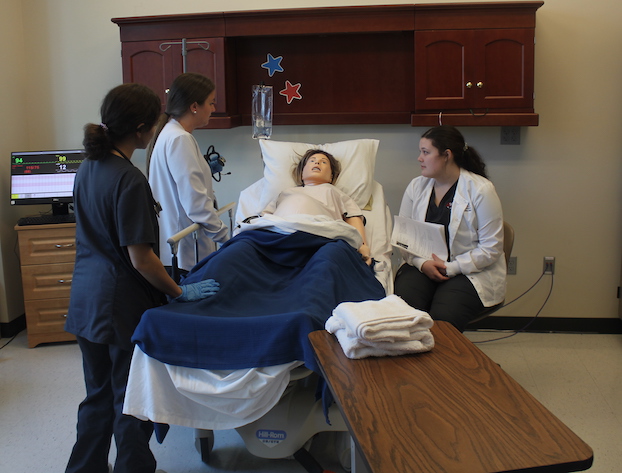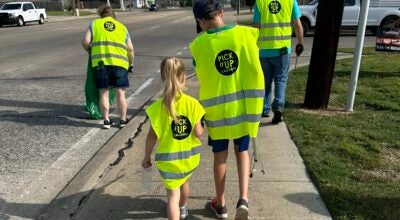Sowela debuts new health care immersive simulation lab
Published 6:36 am Tuesday, November 8, 2022

- Sowela Technical Community College nursing students Camila Triana, Kaycee Griffin and Halee Godman participate in an immersive simulation lab scenario. (Emily Burleigh / American Press)
Sowela Technical Community College’s immersive simulation lab offers both nursing students and doctors-in-training who are part of the Memorial/LSUHSC Family Medicine Residency Program the opportunity to turn didactic knowledge into experience.
The simulation lab, which is located in H.C. Drew Nursing and Allied Health Building, houses multiple state-of-the-art mannequins that breathe, bleed and sometimes birth. These mannequins include a newborn, a pregnant woman, adult man and elderly woman.
The lab drops students into high-fidelity — the highest level of realism — simulations that force them to act out both routine and abnormal situations that would arise on the job. Beth Morrissey, RN and Sowela simulation lab coordinator, said the simulations breed efficiency and precision. “When we practice here, we practice perfectly,” she said. “So, if anything goes wrong, they have to start over.”
She said the high-pressure scenarios the students participate in engage them with what they learned in the classroom, and synthesize this knowledge into practical skill.
“If you take didactic knowledge — what you learn in a book, reading, watching videos — and you add time constraints, complexity and stress, that didactic information moves into critical thinking,” she said. “It’s still stress and your body doesn’t know the difference, and it’s that stress that moves that information to critical thinking.
“We need to be able to take the knowledge that they’ve studied and be able to pull it out of their brain and apply it to a patient,” said Renne Thornton, RN, nurse practitioner and Sowela obstetrics, gynecology and pediatrics faculty nursing instructor. “That’s the challenge.”
Sowela’s nursing students move through different layers of learning to diversify their learning experience. They start in the classroom with textbook learning. Then, they participate in case studies via virtual simulations. It is after these virtual simulations that they enter the high-fidelity simulation lab.
While in the simulation, students act out their case study with the realistic mannequins. On the other side of the two-way mirror glass windows, their instructors are controlling the mannequin breathing, heart rate and other functions. The simulations are recorded, and students are required to observe and commentate on their performance.
Nursing student Kaycee Griffin said she believes this is an effective way to learn.
“You can look back and see what you would do differently if you were in a real-life situation before you’re actually in the real-life situation.”
“I feel like you learn more that way,” added Camila Triana, a fellow nursing student.
The realistic nature of the simulations are supported by the participation of the Memorial/LSUHSC Family Medicine residents who join the nursing students. This partnership between LSU and Sowela is a mutually beneficial one. Over the summer, the residents utilize the lab. In exchange, they join the nursing students to create a more realistic simulation.
Dr. Logan Soileau, Memorial/LSU Family Medicine resident, said the doctors benefit from the simulations, as well, because their knowledge is solidified through interacting and educating the nursing students.
“When you’re a resident, you’re still doing just as much learning as you are treating, but if you can teach it, then you know it,” he said. “It’s important to know how to interact with nursing staff and seeing them from the ground up, and seeing what questions or fears they might have really helps us.”
“It’s always a good experience, just working with the nursing students in the sim labs,” said Dr. Jason Fong, Memorial/LSU Family Medicine resident. He said he would have benefited from high-fidelity simulations as a student.
“I wish I’d done more of the sim labs before having seen some emergencies during the OB.”
Morrissey said the residents’ participation helps curate the vital interpersonal skills that they will need in the field. “We want the nurse to be able to identify cues, prioritize cues and take appropriate actions,” she said.
“I think it’s very beneficial to learn how to give reports to a doctor, and just how to communicate because we don’t really get that as nursing students,” said Halle Godman, a Sowela nursing student.
Fellow nursing student Camila Triana agreed, saying interconnectivity among nurses and doctors is vital.
“I think it’s good that we start working as a team, and not as separate parts of the same thing.”
Griffin seconded this. “We have to work together for the benefit of the patient.”
“Having a standard, efficient way of communicating only benefits the patient,” Soileau said. “Never in the history of a hospital has the communication been too good.”





